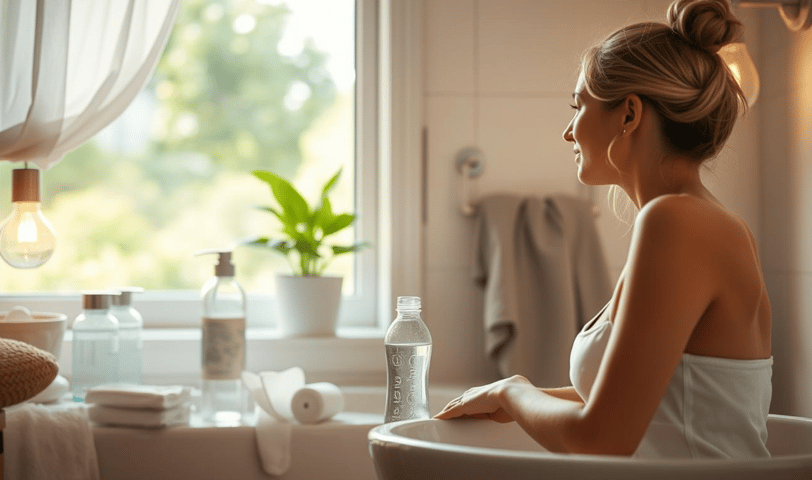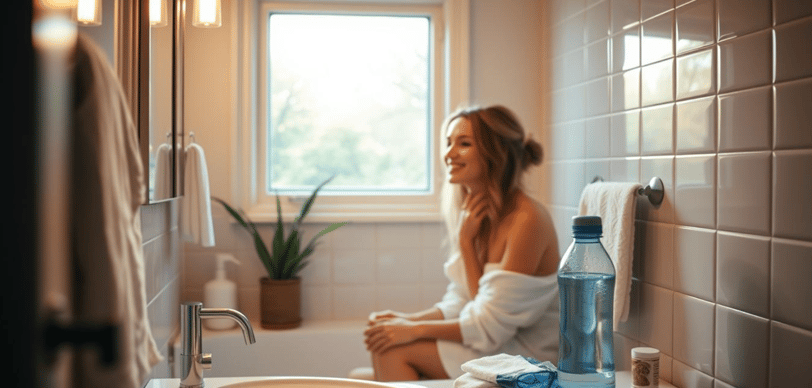Understanding and Managing Urinary Incontinence After 40
Discover effective solutions for urinary incontinence after 40. Learn about bladder control exercises, pelvic floor strengthening, stress incontinence treatment, and lifestyle changes to manage overactive bladder symptoms. Expert tips for women experiencing postmenopausal bladder leakage, including Kegel exercises and natural remedies. Stop letting incontinence affect your daily life - get practical solutions and regain confidence today.
40+WOMEN'S HEALTHBODYSELF CAREWELLNESS
The Better Life Team
10/29/202411 min read
Did you know that over 13 million Americans deal with urinary incontinence? Women are twice as likely to face this issue as men. In fact, up to 50% of older women struggle with it, and the risk grows with age. If you're a woman over 40 facing bladder control problems, you're not alone.
Urinary incontinence means losing urine accidentally, from small leaks to frequent wetting. It's often caused by changes in body function due to diseases, medications, or illnesses. Women are especially at risk during pregnancy, after childbirth, or with menopause's hormonal shifts.


Key Takeaways
Urinary incontinence affects over 13 million Americans, with women being twice as likely to experience it.
Up to 50% of older women suffer from urinary incontinence, with the risk increasing with age.
Urinary incontinence can range from minor leaks to severe, frequent wetting and is often caused by changes in body function.
Women are particularly susceptible to developing urinary incontinence during pregnancy, after childbirth, or due to hormonal changes of menopause.
Understanding and managing urinary incontinence is crucial for maintaining overall health and quality of life.
What is Urinary Incontinence?
Definition and Overview
Urinary incontinence (UI) is when you accidentally pee. It's a common problem in the U.S. and can happen at any age. But, it's more common as people get older, especially for women over 50.
UI can be a small problem or a big one. It might be caused by a short-term illness or a long-term issue. Either way, it can really affect how you feel and live your life.
Prevalence and Impact
Over 25 million adults in the U.S. deal with UI. Women are more likely to have it, with 68% of women aged 42-64 experiencing it monthly.
UI can make you feel embarrassed and lonely. It can even lead to depression. Many people use pads instead of getting help, not knowing what's available.
"Urinary incontinence is more common in women of African American descent than in white women, especially urge incontinence."
Even though UI is common, over 60% of women who have it get help. With the right treatment and changes, many people can manage UI and live better.
Types of Urinary Incontinence
Urinary incontinence is a common issue that affects many, especially as we get older. Knowing the different types is key to finding the right treatment. Let's look at each type and how they show up.
Urgency Incontinence
Urgency incontinence, or "overactive bladder," is when you feel a strong need to pee suddenly. This urge is hard to stop, leading to leaks. About 25% of bladder control issues are just urgency, and 55% are both urgency and leaks.
Stress Incontinence
Stress incontinence happens when you pee during activities like coughing or laughing. It's often due to weak pelvic muscles. Research shows 82% of leaks happen after stress activities.
Functional Incontinence
Functional incontinence is caused by physical or mental issues that make it hard to get to the bathroom. This can be due to arthritis, Alzheimer's, or mobility problems.
Overflow Incontinence
Overflow incontinence is when your bladder is too full, causing leaks. This can happen if your bladder muscle is weak or blocked. Stress-induced urgency incontinence is the most common, affecting 29% of people. Urgency incontinence affects 27%, and stress incontinence affects 16%.
It's important to understand each type of urinary incontinence to find the right treatment. By knowing the causes, we can manage it better and live better lives.

Causes and Risk Factors
Urinary incontinence is a common problem for many women, especially as they get older. There are several key risk factors to know about. Let's explore the main causes of this condition.
Age-Related Changes
As we age, our bodies change in ways that can lead to urinary incontinence. The muscles that control the bladder can weaken, causing urine to leak. The bladder itself may also lose its ability to hold urine well.
Pregnancy and Childbirth
Pregnancy and childbirth can harm the muscles and nerves in the pelvic area. This can increase the risk of urinary incontinence. About 41.25 percent of pregnant women find they need to urinate more often. Also, 68.8 percent experience discomfort or distress from this issue.
Menopause and Hormonal Changes
The hormonal shifts during menopause can also lead to urinary incontinence. With lower estrogen levels, the urethra and bladder become less elastic. This makes it harder to control urination. The transition period before menopause, called perimenopause, can last 7-14 years and bring bladder symptoms.
Understanding the causes and risk factors of urinary incontinence helps women manage it better. They can try pelvic floor exercises, bladder training, and get medical help when needed. These steps can help address this common but treatable issue.
"Overactive bladder (OAB) affects as many as 40% of females in the United States, showing that it is a prevalent issue among women."
Symptoms and Diagnosis
Dealing with urinary incontinence can be tough. But knowing the common symptoms and how doctors diagnose it is a big step. Let's look at what to watch for and how doctors figure out if you have it.
The signs of incontinence can differ a lot. But some common ones are:
Needing to rush to the restroom and/or losing urine if you do not get there in time
Urine leakage with movements, exercise, or physical activity
Leakage that prevents you from engaging in your usual activities
Urine leakage with coughing, sneezing, or laughing
A constant feeling of wetness without a clear sensation of urine leakage
To diagnose urinary incontinence, doctors will do a full check-up. They'll also look at your medical history. They might ask for urine samples or other tests to find the cause. This incontinence evaluation is key to making a good treatment plan.
"Up to half of women over 40 experience incontinence, with the trend increasing with age."
By knowing the symptoms of urinary incontinence and the incontinence testing steps, you can start to take back control. Remember, you don't have to suffer in silence. Getting professional help is the first step to finding the right solutions for you.


Urinary Incontinence in Women 40+
Urinary incontinence becomes more common for women in their 40s and beyond. A huge two-thirds of women over 40 deal with bladder leakage. This makes them feel embarrassed and depressed.
Millions of females are affected, with nine out of 10 saying it greatly impacts their life. One-tenth even experience depression because of it.
Interestingly, 98% of women worry about leakage as they get older. But, 55% think it's just part of aging. The truth is, incontinence isn't a must-have with age.
The main types are stress incontinence and urge incontinence. These are often caused by weakened pelvic muscles from childbirth or aging. An overactive bladder is another common cause.
"A staggering 98% of women are concerned about leakage in older age, with 55% believing it is an inevitable part of aging."
Many women don't get the help they need. Research shows 59% haven't talked to their partners about bladder leakage. One in 10 women say they can't fully enjoy life because of it.
But, there's good news. There are many ways to manage urinary incontinence in women 40 and older. Options include pelvic floor exercises, bladder training, dietary changes, and medication.
By understanding the causes and getting professional help, women can control their bladder health. This improves their quality of life.
Lifestyle and Behavioral Modifications
Living a healthy lifestyle can greatly help with urinary incontinence. Simple changes can make a big difference. Here are some key strategies to consider:
Bladder Training
Bladder training helps you hold your urine longer. It involves a schedule to gradually increase time between bathroom visits. This strengthens your bladder muscles and improves control.
Pelvic Floor Exercises (Kegel)
Pelvic floor exercises, or Kegels, are great for bladder control. They target muscles that support the bladder and urethra. This helps you gain better control over these muscles.
Diet and Fluid Management
What you eat and drink matters for urinary incontinence. Avoiding caffeine, alcohol, and citrus can help. Staying hydrated is also important to reduce incontinence episodes.
By making these lifestyle changes, you can manage your bladder control better. Talking to a healthcare professional can help create a plan for you.


"Regular, daily exercising of the pelvic muscles can improve and even prevent urinary incontinence."
Medical and Surgical Treatments
There are many ways to manage urinary incontinence besides lifestyle changes. Medical and surgical treatments can offer a lot of relief. They can greatly improve the quality of life for those over 40 who deal with incontinence.
Medications
Some medicines, like anticholinergic drugs and vaginal estrogen, can help with incontinence. Anticholinergics relax the bladder muscle and stop unwanted contractions. Vaginal estrogen therapy strengthens the pelvic floor and improves bladder function.
Nerve Stimulation
Nerve stimulation, or neuromodulation, uses mild electrical pulses. It stimulates nerves that control the bladder and urethra. This method can make the muscles that control the bladder stronger, reducing incontinence episodes.
Surgical Procedures
For severe or ongoing incontinence, surgery might be needed. Treatments include bladder slings, bladder suspensions, and peripheral nerve stimulation. These aim to better control the bladder and stop urine leaks.
It's crucial to talk to a healthcare provider to find the best treatment. This depends on the person's specific needs and the type of incontinence they have.
Incontinence Products and Management
Living with urinary incontinence doesn't mean you have to lose comfort or confidence. There are many absorbent products and bladder control devices to help manage incontinence. These include adult diapers, incontinence pads, and special underwear. They offer discreet and effective ways to handle this common issue.
Absorbent Products
Absorbent incontinence products like adult diapers, pads, and underwear are made to stop urine leaks. They come in various sizes, absorbencies, and styles to fit different needs. These products use advanced materials and are designed to be discreet, keeping you dry and comfortable.
Bladder Control Devices
For some, bladder control devices like catheters and vaginal pessary rings can help manage incontinence. These devices either prevent leaks or block the urethra to control bladder. While they require more effort, they can be a good alternative to absorbent products.
Incontinence products and management solutions are key to a good quality of life for those with urinary incontinence. By looking into the many options available, women can find the best products and strategies. This way, they can manage their condition discreetly and with confidence.
Emotional and Social Impact
Urinary incontinence deeply affects those who have it. Many women feel embarrassed and anxious about it. They might avoid social events and skip exercise because of leakage or odor fears.
This condition can really hurt a woman's self-esteem and quality of life. Up to 40% of women over 40 deal with incontinence. Also, 65% of women in this age group face urogenital atrophy, making daily life harder.
The social effects are just as big. Around 30% of midlife women face discrimination, violence, and neighborhood issues. Incontinence can also strain personal relationships. Women might feel too embarrassed to talk about it with their partners.
This can make them feel isolated and out of control. But, it's key to know that incontinence is treatable. There are ways to manage it without letting it stop you.
"Urinary incontinence can be a significant source of embarrassment and social isolation for many women. It's crucial that we destigmatize this issue and empower women to seek the help they need to regain control of their bladder health and improve their quality of life."
By getting professional help and trying different management options, women can lessen the emotional and social effects. They can keep living active lives and maintain their relationships. With the right support and treatment, women can beat incontinence and regain their independence and confidence.
Seeking Professional Help
If you're dealing with urinary incontinence, it's time to talk to your doctor. Getting professional help is the first step to better bladder control and a better life. Your doctor will do a detailed check-up. This might include a physical exam, looking at your medical history, and tests to find out why you're leaking.
When you see your doctor, be ready to share your symptoms. Talk about how often and how bad the leaks are. Also, mention anything that makes it worse. Your doctor will then suggest the best treatment for you. This could be changes in your lifestyle, medicine, or even special therapies like pelvic floor exercises or nerve stimulation.
If your regular doctor thinks you need more help, they might send you to a urogynecologist or urologist. These doctors are experts in dealing with incontinence and other urinary problems. They'll do a full check-up and make a plan just for you.
Don't let incontinence hold you back. By talking to your doctor and working together, you can find ways to manage it. Take action and book an appointment with your doctor today.
"Don't be afraid to advocate for yourself. Incontinence is a common issue, and your doctor is there to help you find the right treatment plan."
Conclusion
Urinary incontinence is a common issue that affects many women over 40. It's good to know the different types and their causes. This knowledge helps us manage our bladder health better.
There are many ways to tackle incontinence. We can try lifestyle changes, like bladder training and pelvic floor exercises. Or, we can look into medical treatments and incontinence products. With the right help, we can manage our symptoms and live better lives.
Don't feel alone if you're dealing with incontinence. It's a common problem. With the right information and support, we can regain control. We can keep doing the things we love and live a better life.
FAQ
What is urinary incontinence?
Urinary incontinence is when you accidentally pee. It's common, affecting over 25 million adults in the U.S. Women over 50 are more likely to experience it.
What are the different types of urinary incontinence?
There are several types. These include urgency incontinence, stress incontinence, functional incontinence, and overflow incontinence.
What causes urinary incontinence?
It's often due to changes in body function. This can be from diseases, medication side effects, or illness. Women often get it during pregnancy, after childbirth, or during menopause.
What are the common symptoms of urinary incontinence?
Symptoms include needing to pee fast, losing urine with movement, or feeling wet without knowing why. It can also happen with coughing, sneezing, or laughing.
How common is urinary incontinence in women over 40?
It's very common in women over 40. A study found 68% of women between 42 and 64 experience it monthly.
What lifestyle and behavioral modifications can help manage urinary incontinence?
Changes like bladder training and Kegel exercises can help. So can managing your diet and fluid intake.
What medical and surgical treatments are available for urinary incontinence?
Treatments include medications and nerve stimulation. Surgery is also an option to improve bladder control.
What incontinence products and devices are available?
Women use pads, shields, or diapers for leakage. Devices like catheters and vaginal rings can also help prevent leaks.
How can urinary incontinence impact emotional and social well-being?
It can make you feel embarrassed and avoid social events. It can also lower your self-esteem and affect your quality of life.
When should someone seek professional help for urinary incontinence?
If you notice any signs, talk to your doctor. They can find the cause and suggest treatment.
Source Links
Urinary incontinence in menopause: are you ignoring the symptoms? - balance menopause - https://www.balance-menopause.com/menopause-library/urinary-incontinence-in-menopause-are-you-ignoring-the-symptoms/
Incontinence: A Woman's Little Secret - https://www.webmd.com/urinary-incontinence-oab/features/incontinence-womans-little-secret
Urinary Incontinence in Women - https://www.hopkinsmedicine.org/health/conditions-and-diseases/urinary-incontinence/urinary-incontinence-in-women
Urinary incontinence problematic for many women over 40, study finds - SWAN - Study of Women’s Health Across the Nation - https://www.swanstudy.org/urinary-incontinence-problematic-for-many-women-over-40-study-finds/
Mixed Incontinence Masked as Stress Induced Urgency Urinary Incontinence - https://www.ncbi.nlm.nih.gov/pmc/articles/PMC5025340/
How to Stop Bedwetting in Adults - https://www.alwaysdiscreet.co.uk/en-gb/incontinence-advice/bladder-leakage-in-women/how-to-stop-bedwetting-in-adults
Can You Have Overactive Bladder as a Young Adult? - https://www.healthline.com/health/overactive-bladder-young-age
Perimenopause and overactive bladder: Link and treatment - https://www.medicalnewstoday.com/articles/overactive-bladder-perimenopause
These 10 Illnesses Are More Common After 40 - https://www.health.com/condition/osteoarthritis/40s-common-illnesses
Frequent urination in women: Causes, symptoms, and treatment - https://www.medicalnewstoday.com/articles/316669
Managing Urinary Incontinence in Menopause - https://www.feistymenopause.com/blog/urinary-incontinence-in-menopause
Urinary Incontinence in Women - Causes and Treatment of UI - https://helloclue.com/articles/cycle-a-z/urinary-incontinence-101
Two-thirds of women over 40 suffer from bladder leakage, research shows - https://www.news-medical.net/news/20190905/Two-thirds-of-women-over-40-suffer-from-bladder-leakage-research-shows.aspx
9 Smart Ways to Manage a Leaky Bladder - https://www.everydayhealth.com/urinary-incontinence-photos/living-well-with-urinary-incontinence.aspx
Menopause - StatPearls - NCBI Bookshelf - https://www.ncbi.nlm.nih.gov/books/NBK507826/
40 Science-Backed Health Tips for Women Over 40 You Need to Know - https://www.prevention.com/health/g42508464/how-to-stay-healthy-women-over-40/
Urinary tract infection - adults - UF Health - https://ufhealth.org/conditions-and-treatments/urinary-tract-infection-adults
Can Vaginal Hormones Help With Incontinence? - National Association For Continence - https://nafc.org/bhealth-blog/can-vaginal-hormones-help-with-incontinence/
Women’s Midlife Health - https://link.springer.com/10.1007/978-3-030-45009-0_129
The role of obesity on urinary incontinence and anal incontinence in women: a review - https://www.binasss.sa.cr/ene1/20.pdf
Eight Common Health Challenges for Women Over 40 - https://walkin-clinic.co.uk/blog/womens-health/8-common-health-challenges-for-women-over-40
Incontinence - Not the New Normal - Onondaga Physical Therapy - https://onondagapt.com/incontinence/